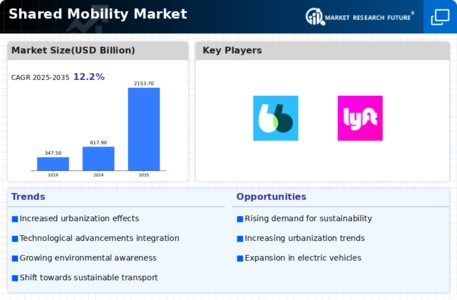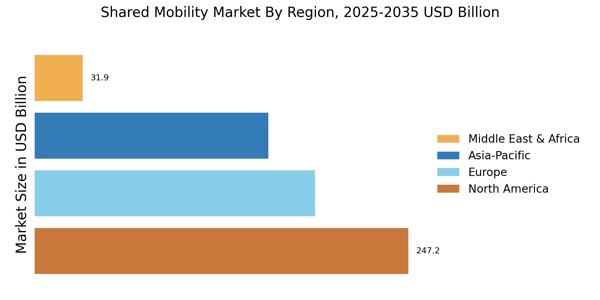The Shared Mobility Market is currently characterized by a dynamic competitive landscape, driven by technological advancements, changing consumer preferences, and a growing emphasis on sustainability. Major players such as Uber Technologies (US), Didi Chuxing (CN), and Grab Holdings (SG) are strategically positioning themselves to capitalize on these trends. Uber Technologies (US) continues to innovate its platform, focusing on integrating electric vehicles into its fleet, which aligns with global sustainability goals. Didi Chuxing (CN) is expanding its services beyond ride-hailing into areas such as autonomous driving, indicating a shift towards more advanced mobility solutions. Meanwhile, Grab Holdings (SG) is enhancing its super app model, which combines various services, including food delivery and financial services, thereby creating a comprehensive ecosystem that attracts a diverse user base.
The business tactics employed by these companies reflect a moderately fragmented market structure, where localized strategies and supply chain optimization play crucial roles. Companies are increasingly localizing their services to cater to regional preferences, which enhances customer satisfaction and loyalty. This localized approach, combined with strategic partnerships and technological investments, allows these players to maintain a competitive edge while navigating the complexities of the shared mobility landscape.
In August 2025, Uber Technologies (US) announced a partnership with a leading electric vehicle manufacturer to accelerate the transition of its fleet to electric vehicles. This strategic move not only reinforces Uber's commitment to sustainability but also positions the company favorably in a market that is increasingly prioritizing eco-friendly transportation options. The partnership is expected to enhance operational efficiency and reduce costs in the long run, thereby strengthening Uber's market position.
In September 2025, Didi Chuxing (CN) launched a pilot program for its autonomous ride-hailing service in select urban areas. This initiative marks a significant step towards the integration of autonomous technology in shared mobility, potentially transforming the user experience and operational dynamics. By investing in autonomous vehicles, Didi aims to reduce operational costs and improve safety, which could lead to a competitive advantage in the rapidly evolving market.
In July 2025, Grab Holdings (SG) expanded its super app capabilities by integrating a new feature that allows users to book shared rides directly through its platform. This enhancement not only streamlines the user experience but also positions Grab as a one-stop solution for various mobility needs. The integration of shared rides into its existing services is likely to increase user engagement and retention, further solidifying Grab's market presence.
As of October 2025, the competitive trends in the Shared Mobility Market are increasingly defined by digitalization, sustainability, and the integration of artificial intelligence. Strategic alliances are becoming more prevalent, as companies recognize the need to collaborate to enhance their technological capabilities and service offerings. Looking ahead, competitive differentiation is expected to evolve from traditional price-based competition to a focus on innovation, technology integration, and supply chain reliability. This shift underscores the importance of adaptability and forward-thinking strategies in navigating the complexities of the shared mobility landscape.


















Leave a Comment